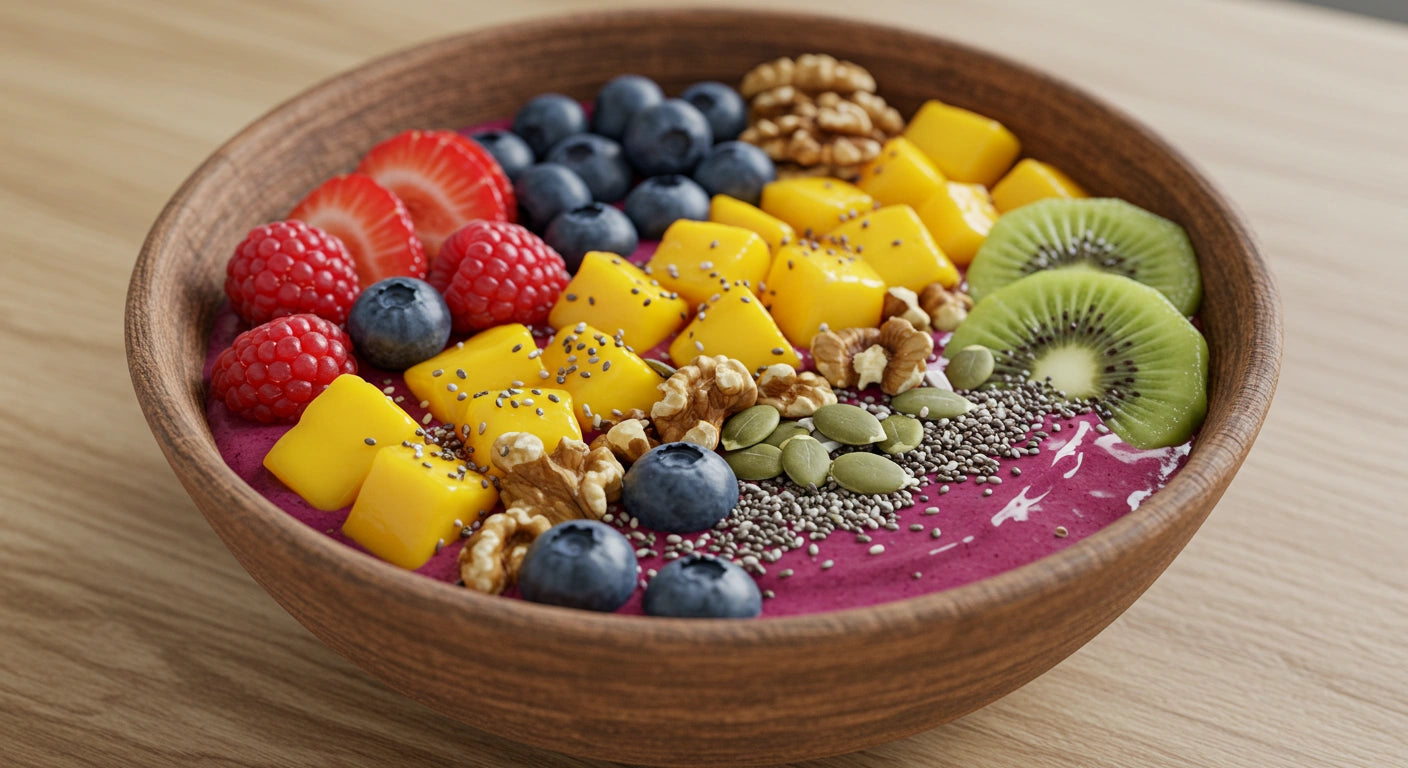
Creative Ways to Incorporate Frozen Fruit into Your Daily Diet
Teilen
The freezer section's fruit offerings have quietly become one of the smartest shopping choices for health-conscious consumers seeking convenience without compromising nutrition. While fresh fruit certainly has its place, frozen fruit provides unmatched versatility, extended shelf life, and consistent availability that make healthy eating more achievable throughout the year.
From tropical varieties available in winter to perfect portioning for individual needs, frozen fruit opens doors to creative culinary possibilities that many home cooks have yet to explore.
Modern freezing technology captures fruit at peak ripeness, often preserving nutrients better than fresh alternatives that travel long distances or sit in storage. This preservation advantage, combined with the convenience of having pre-washed, pre-cut fruit ready for immediate use, makes frozen fruit an invaluable tool for maintaining consistent healthy eating habits regardless of seasonal availability or busy schedules.
The Nutritional Value of Frozen Fruit
Understanding how freezing affects fruit nutrition helps consumers make informed choices about incorporating these convenient options into their daily meals.

Preservation of Essential Nutrients
The freezing process effectively locks in vitamins, minerals, and antioxidants at their peak levels:
- Vitamin C retention - Frozen fruits often maintain higher vitamin C levels than fresh fruits stored for extended periods
- Antioxidant preservation - Freezing prevents the breakdown of beneficial compounds like anthocyanins and flavonoids
- Mineral stability - Essential minerals remain largely unaffected by the freezing process
- Fiber content - Dietary fiber levels remain consistent between fresh and frozen varieties
- Natural sugar preservation - No added sugars in plain frozen fruit, maintaining natural sweetness levels
Frozen Versus Fresh Fruit Nutrition
Fresh fruit at peak ripeness provides optimal nutrition, but this window is often brief and timing-dependent. Frozen fruit maintains nutritional quality consistently, making it reliable for daily consumption planning. The key difference lies in texture rather than nutritional content, with frozen fruit offering different culinary applications than fresh alternatives.
Commercially frozen fruit undergoes minimal processing beyond washing, cutting, and flash-freezing, preserving the natural nutrient profile. Some water-soluble vitamins may decrease slightly during the blanching process used for certain fruits, but the overall nutritional impact remains minimal for most consumers.
Easy and Creative Recipes with Frozen Fruit
Frozen fruit opens numerous culinary possibilities that extend far beyond simple thawing and eating.
Smoothies and Smoothie Bowls
Frozen fruit creates the perfect smoothie base, providing natural thickness and cooling properties without requiring ice:
- Berry blends - Combine frozen strawberries, blueberries, and raspberries for antioxidant-rich breakfast options
- Tropical combinations - Mix frozen mango, pineapple, and banana for vitamin C-packed energy boosters
- Green smoothie additions - Add frozen fruit to mask vegetable flavors while maintaining nutritional benefits
- Protein smoothie enhancement - Incorporate frozen fruit with protein powder for post-workout recovery drinks
- Smoothie bowl toppings - Use partially thawed frozen fruit as colorful, nutritious garnishes
The key to successful smoothie creation lies in balancing frozen fruit with liquid ratios and allowing slight thawing for easier blending. Different fruit combinations create varying flavor profiles and nutritional benefits, encouraging experimentation with seasonal preferences and dietary goals.
Frozen Fruit Desserts
Healthy dessert options become simple and satisfying when using frozen fruit as the primary ingredient. Sorbets require minimal ingredients - primarily frozen fruit, a small amount of sweetener, and citrus juice processed in a food processor until smooth and creamy.
Parfaits layer frozen fruit with yogurt and granola, creating visually appealing desserts that provide protein, probiotics, and fiber. The contrast between cold fruit and room-temperature accompaniments creates interesting textural experiences that feel indulgent while supporting nutritional goals.
Baking Applications
Frozen fruit works exceptionally well in baked goods, often performing better than fresh alternatives that release excess moisture during cooking. The frozen state helps fruit maintain shape and distribution throughout batters, preventing sinking that commonly occurs with fresh fruit additions.
Muffins, quick breads, and coffee cakes benefit from frozen fruit additions that provide bursts of flavor and natural sweetness. The fruit pieces remain distinct rather than dissolving into the batter, creating an appealing visual and textural contrast in finished products.
Using Frozen Fruit in Breakfast Applications
Morning meals provide excellent opportunities for incorporating frozen fruit into daily nutrition routines.
Oatmeal and Cereal Enhancements
Adding frozen fruit to hot oatmeal creates natural cooling that brings the dish to eating temperature while infusing flavor and nutrition:
- Berry oatmeal - Stir frozen berries into hot oats for natural sweetness and antioxidant boost
- Tropical oats - Add frozen mango or pineapple chunks for an exotic breakfast variety
- Mixed fruit combinations - Create custom blends that prevent breakfast monotony
- Overnight oats preparation - Use frozen fruit in cold overnight oat recipes for convenient grab-and-go options
- Cereal toppers - Sprinkle partially thawed frozen fruit over cold cereals for added nutrition
Pancakes and Waffles Integration
Frozen fruit incorporated directly into pancake and waffle batters creates bursts of flavor throughout the cooking process. The frozen state prevents excessive bleeding of fruit juices that can affect batter consistency and final texture.
Blueberry pancakes become more achievable year-round when using frozen berries, while tropical fruit waffles offer exotic breakfast experiences regardless of seasonal availability. The fruit pieces cook gently within the batter, maintaining their shape while contributing moisture and natural sweetness.
Frozen Fruit in Snacks and Beverages
Creative snacking and beverage options expand the daily applications of frozen fruit beyond traditional meal components.
Infused Waters and Refreshing Drinks
Frozen fruit serves as both a flavoring agent and an ice substitute in beverages:
- Natural ice cubes - Freeze fruit pieces in ice cube trays for slowly flavoring drinks as they melt
- Spa water alternatives - Add frozen berries or citrus to plain water for subtle flavor enhancement
- Smoothie alternatives - Blend frozen fruit with sparkling water for lighter, effervescent drinks
- Tea enhancements - Add frozen fruit to iced teas for natural sweetening and flavor complexity
- Mocktail ingredients - Use colorful frozen fruit as garnishes and flavor components in non-alcoholic cocktails

Healthy Snack Innovations
Frozen fruit eaten directly provides satisfying snacks that take time to consume, naturally controlling portion sizes. The cold temperature creates a refreshing experience, particularly appealing during warm weather or after physical activity.
Frozen grapes offer candy-like satisfaction with natural sweetness, while frozen mango chunks provide tropical indulgence without added sugars or artificial ingredients. These options satisfy sweet cravings while contributing vitamins, minerals, and fiber to daily nutrition intake.
Cooking and Savory Applications
Frozen fruit extends beyond sweet applications into savory cooking territory, offering unexpected flavor enhancements for main dishes and accompaniments.
Salad Enhancements
Thawed frozen fruit adds seasonal variety to salads throughout the year. Frozen berry blends provide antioxidant-rich additions to green salads, while tropical frozen fruit creates interesting flavor contrasts with savory ingredients.
The key to successful salad integration involves proper thawing techniques that maintain fruit integrity while removing excess moisture that could dilute dressings or make salads soggy. Brief thawing at room temperature or gentle warming preserves texture while making fruit palatable for fresh consumption.
Sauces and Marinades
Frozen fruit creates excellent bases for savory sauces and marinades that complement various protein sources. Berry-based sauces pair beautifully with poultry and game meats, while tropical fruit marinades enhance fish and pork preparations.
The concentrated flavors in frozen fruit recipes often surpass fresh alternatives because freezing breaks down cell walls, releasing more intense flavors during cooking. This characteristic makes frozen fruit particularly valuable for sauce making, where flavor concentration is desirable.
Glaze and Accompaniment Options
Fruit-based glazes using frozen ingredients provide attractive finishes for roasted meats and vegetables. The natural sugars in fruit create appealing caramelization during high-heat cooking while contributing complex flavor profiles that enhance rather than mask primary ingredients.
Chutneys and relishes featuring frozen fruit offer year-round accessibility to seasonal flavor combinations that traditionally require specific harvest timing. These preparations can be made in small batches as needed rather than requiring large-scale preservation efforts.
Conclusion
The versatility of frozen fruit extends far beyond simple convenience, offering creative culinary opportunities that support both nutritional goals and flavor preferences throughout the year. From morning smoothies and breakfast enhancements to evening desserts and savory accompaniments, frozen fruit provides consistent quality and availability that makes healthy eating more achievable and enjoyable.
Success with frozen fruit lies in understanding its unique characteristics and advantages rather than viewing it as a compromise alternative to fresh options. The preservation of nutrients, extended shelf life, and creative applications make frozen fruit a valuable component of balanced daily nutrition that deserves consideration in meal planning and recipe development.

